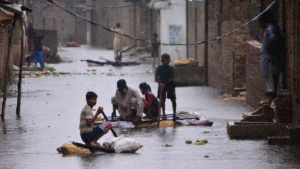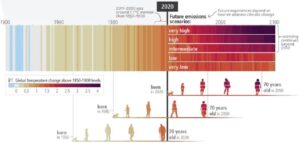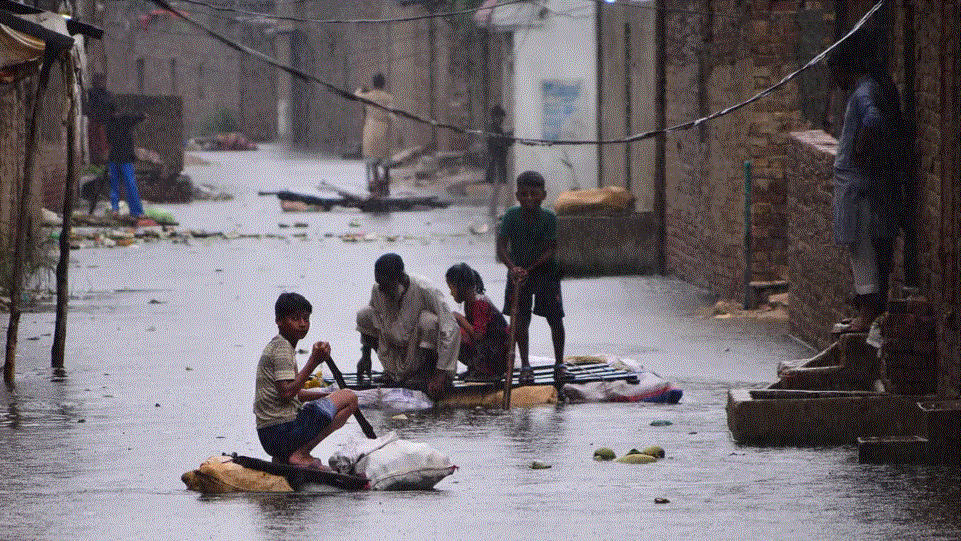53
 Residents use makeshift rafts after flooding on an unprecedented scale in Pakistan, Hyderabad, August 24, 2022. (AKRAM SHAHID / AFP)
Residents use makeshift rafts after flooding on an unprecedented scale in Pakistan, Hyderabad, August 24, 2022. (AKRAM SHAHID / AFP)
The United Nations Intergovernmental Panel on Climate Change has published its sixth report.
“Climate change is a threat to the well-being of humanity and the health of the planet. There is a window of opportunity to secure a livable and sustainable future for all, which is rapidly closing.” The Intergovernmental Panel on Climate Change (IPCC) published, on Monday 20 March, the summary of its sixth report. The scientific body summarizes the three previous documents devoted to the state of knowledge on climate change, its consequences and the solutions to be provided. Its “Summary for Policymakers” has been endorsed by delegations from 195 countries.
“Current trends are not at all compatible with the stabilization of warming, which would ensure a livable and equitable world. Efforts that have been made, but they do not reach the sufficient scale for a sufficiently rapid decline in greenhouse gas emissions”
The Earth has already warmed by 1.1°C since the pre-industrial era
The IPCC begins by recalling the current situation: human activities, in particular the combustion of fossil fuels such as coal, oil and gas, have emitted greenhouse gases at an increasing rate, reaching a concentration of CO2 in the atmosphere “the highest for at least 2 million years”. The result, and this in an “indisputable” way, is a warming of the average temperature on Earth of +1.1°C compared to the period 1850-1900, as well as a rise in sea level of 20 centimeters between 1901 and 2018. The IPCC specifies that the rise attributed to human activities is 1.07°C.
“This has led to an increase in the frequency and intensity of extreme weather events, which have had increasingly dangerous effects on nature and people in all regions of the world,” writes the IPCC. The group cites many consequences, such as a decline in food security and access to water, the loss of human lives, the extinction of hundreds of species, the occurrence of diseases and traumas, or even “increasing” displacements of populations.
Current actions and commitments are “insufficient”
To cope with this warming, adaptation plans and policies for mitigating greenhouse gas emissions have multiplied in all sectors and all regions of the world, recognizes the IPCC. However, “the pace and scale of the measures taken so far, as well as the current projects, are insufficient to tackle climate change”, insists the group of experts. While emissions “should already be falling now” to keep warming to +1.5°C, as advocated by the Paris agreement, “greenhouse gas emissions have continued to rise”, states the report .
Many countries have declared their intention to achieve carbon neutrality by the middle of the century, but “few policies are currently in place to keep this promise”, underlines the IPCC, which points to the “gap” between the commitments and their implementation. If this gap persists, it would take us beyond the +1.5°C mark during the century and lead us to a warming of 3.2°C by 2100, the report states. The IPCC adds that forecasts of CO2 emissions linked to the combustion of fossil fuels extracted from existing sites “would exceed the remaining carbon budget to [maintain warming at] 1.5°C”.
We are really on a much slower action than what would be necessary.
The IPCC illustrates these warming trajectories in an eloquent frieze, where each year is represented by a vertical line – blue when the year is colder than the average temperature recorded between 1850 and 1900, red when it is warmer. We see that a person born in 2020 will live in a much warmer climate at the age of 70, the intensity of the warming depending on the level of greenhouse gas emissions.
 An infographic illustrates future warming scenarios in the IPCC’s sixth report released on March 20, 2023. (IPCC)
An infographic illustrates future warming scenarios in the IPCC’s sixth report released on March 20, 2023. (IPCC)
Every additional fraction of a degree threatens ecosystems
With each additional fraction of a degree, the risks intensify, describes the IPCC. “More intense heat waves, more abundant rainfall and other extreme weather events [which] further increase the risks to human health and ecosystems”, list the experts.
Some effects will manifest themselves in the very long term. Thus, sea level rise “is inevitable for centuries, if not millennia, due to the continued warming of deep oceans and melting ice caps, and sea levels will remain high for thousands of years. of years”, details the report. The rise could reach 2 to 3 meters in the next 2000 years if the warming is kept below 1.5°C, and 2 to 6 meters for a warming limited to 2°C. With an average global temperature of +2°C, “the ice caps of Greenland and West Antarctica will disappear almost completely and irreversibly over several millennia”, further exposes the IPCC.
The least responsible are the most vulnerable
The IPCC report also mentions the imbalance in responsibility and exposure to the consequences of global warming. “Vulnerable communities, which have historically contributed the least to current climate change, are disproportionately affected,” the experts write. They represent, according to the IPCC, 3.3 to 3.6 billion people. “Most of the negative impacts have affected places and/or communities in Africa, Asia, Central or South America, least developed countries, small islands and the Arctic, and globally indigenous peoples , small food producers and low-income households.
“Over the past decade, deaths from floods, droughts and storms have been 15 times higher in highly vulnerable regions,” said Aditi Mukherji, one of the report’s authors. In the face of this inequality, the report points out, “prioritizing equity, climate justice, social justice, inclusion and just transition processes can enable adaptation, mitigation measures ambitions and climate-resilient development.”
The 2020 decade is crucial
In its report, the IPCC repeats that the current decade is “essential” in the fight against climate change. If we want to limit global warming to +1.5°C, we must have reduced our CO2 emissions by 48% by 2030 compared to 2019 levels, he establishes in particular.
“The choices and actions implemented in this decade will have impacts now and for thousands of years”, insists the text. The IPCC warns that “without urgent, effective and equitable adaptation and mitigation [of emissions], climate change will increasingly threaten ecosystems, biodiversity, livelihoods, health and well-being. current and future generations”.
All players have the solutions in their hands
If today, we are “with our backs to the wall, (…) solutions exist”, insists Valerie Masson-Delmotte. The IPCC report emphasizes that all actors have their role to play.
Rapid and deep transitions across all sectors and systems are needed to achieve deep and lasting reductions in emissions, and ensure a livable and sustainable future for all.
To achieve this, many “mitigation and adaptation options” are “effective and inexpensive” and above all “already available”, adds the report. The IPCC first cites the transition “from fossil fuels to sources with little or no greenhouse gas emissions”, highlighting solar and wind energy. It also evokes a transition towards a more plant-based diet, reforestation, the electrification of uses, sobriety efforts, “the conservation of around 30 to 50% of the earth’s freshwater and ocean lands on the planet” and the capture carbon to “offset hard-to-lower emissions”. But also financial tools, such as “removing fossil fuel subsidies”.
The IPCC warns of the dangers of techno-optimism: “Technological innovation can lead to counterparts such as new and greater environmental impacts, social inequalities, excessive dependence on foreign knowledge and suppliers (… ) and rebound effects.”
These solutions, detailed in a previous report, are in the hands of many players, at all levels of decision-making. The levels of local and national institutions are mentioned, as well as international cooperation. That of consumers too, because acting on demand would reduce 40 to 70% of global greenhouse gas emissions from many sectors by 2050.
Funding for climate action must greatly increase
While the IPCC notes an increase in climate finance over the past ten years, it regrets that “public and private financial flows for fossil fuels remain greater than those for climate change adaptation and mitigation”.
Current levels of investment would have to be “three to six times higher” to limit warming to 2°C or 1.5°C, writes the report. “Accelerating climate action will only be possible if funding is scaled up. Insufficient and misdirected funding impedes progress,” says one of the authors, Christopher Trisos. The group of experts repeats again, with supporting studies, that the cost of action is less important than that of inaction.
Climate action has many “co-benefits”
Solutions aimed at reducing our greenhouse gas emissions and adapting to the already visible consequences do not only have an effect on our resilience to climate change, they also have “wider benefits”, welcomes the IPCC . The expert group lists “improving agricultural productivity, innovation, health and well-being, food and livelihood security, and biodiversity conservation”.
In transport, illustrates the IPCC, “low-carbon electrification, walking, cycling and public transport improve air quality, improve health, job opportunities and equity”.

